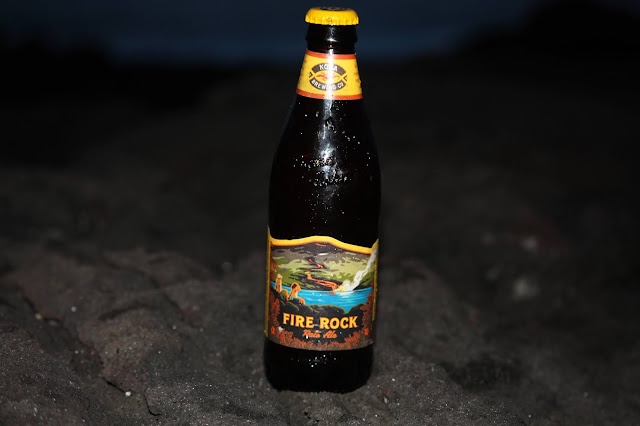The next up in our Drunk on Geology series is the Fire Rock Pale Ale from the Kona Brewing Company.
Like the Volcano Red I did previously, the Fire Rock is named in honor of the Hawaiian Island in which the brewery calls home. The imagery on the bottle depicts the basaltic lava flows characteristic of the Hawaiian Islands as the lava flows into the oceans. Basaltic lava is a fairly high temperature lava with a low silica content. Because of the higher temperatures and low silica content, this type of lava then has a low viscosity, meaning it flows very easily. On the opposite end of the spectrum is felsic lavas which have a high silica content, a lower temperature, and a high viscosity. The high viscosity lavas lead to volcanoes that are steep sided and tend to get plugged up by their own lava flows. These are type of volcanoes most people associate as a volcano, with its stereotypical conical shape. The felsic volcanoes also produce the more explosive eruptions, while the basaltic volcanoes, such as these on Hawaii, are rarely explosive.The much lower viscosity basaltic lavas are not able to create a steep sided volcano. So even though the pictured volcano is conical in shape, typical Hawaiian Island volcanoes are much more laid out with a slight curvature. This curvature is what gives this volcano type its name, shield volcano.
 |
| Graphic depiction of the Hawaiian hotspot. Image courtesy of Clark Science. |
All of the islands of Hawaii are actually volcanoes, with only the Big Island having active volcanoes on it. Hawaii is a special type of volcano known as a hotspot. A hotspot is a type of volcano that sits in one place as the crustal plate on the surface of the Earth rides over it. The source of the magma for a hotspot is an area known as a mantle plume. This spot is essentially "fixed" within the Earth and doesn't move while the plates on the Earth's surface are all moving around on top of it. As the plate moves, the Pacific Plate in this instance, over the hotspot, volcanoes pop up out of the sea floor. As the plate continues to move on, the old volcanoes are pulled away from the hotspot source and die off, while new volcanoes are created.
Text from one side of the bottle neck:
"Active volcanoes on the Big Island of Hawaii leave visitors awestruck by their power. The glow of lava as it meets the ocean is an amazing sight."
On the Big Island there are actually five subaerial volcanoes, of which three are considered active (last erupted in the last 10,000 years): Kilauea, Mauna Loa, and Hualalai. When we had visited the Big Island at the beginning of April in 2018, the glow of the lava, giving the "Fire Rock" its name, could easily be seen within two parts of Kilauea. Here in the main crater, named Halema'uma'u Crater and ...
...and here at the Pu‘U ‘Ō‘Ō crater further to the west along the flanks of Kilauea.
"Our Fire Rock Pale Ale is inspired by this place with a bright copper color and rich roasted malt taste. Aloha!"
Since we were staying the beaches in Kailua-Kona, I was able to get a picture of the Fire Rock Pale Ale along some of Hualalai's lava flows, the same lava flows that the brewery is located upon. Hualalai volcano last erupted from 1800 to 1801, however the volcano started erupting 800,000 years ago and breached the surface of the ocean around 300,000 years ago. The lava flows that underlay the city of Kailua-Kona range in age from 5,000 to 13,000 years old, however with lava flows from the volcano just over 200 years old indicates that this volcano is very much still active. This last, and only historical lava flow, was witnessed by one of Captain Cook's crew who remained on the island.
References









No comments:
Post a Comment
Due to spam, comments are turned off. Please contact me on Twitter @Jazinator for any comments.
Note: Only a member of this blog may post a comment.